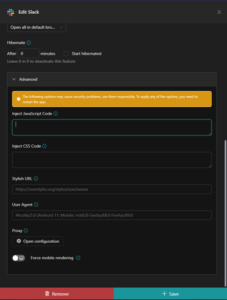Website manipulation can be a powerful tool for developers and marketers alike. By injecting custom JavaScript code into a website or an app, you can automate specific tasks, gather information, and even change the appearance of a website on the fly. This article will explore the best practices for injecting JavaScript code into websites and how to do it safely and efficiently.
Contents
What is JavaScript Injection?
JavaScript injection is the process of adding custom JavaScript code to a website. This code can interact with the website and perform various functions, such as gathering information, modifying the appearance, or even automating certain tasks. JavaScript injection is a powerful technique that requires a good understanding of JavaScript and the Document Object Model (DOM).
The boundaries of JavaScript Injection
JavaScript injection is a legitimate activity for developers when used appropriately and ethically. You can use it to create dynamic content, customize the user experience, automate tasks, and enhance functionality on a web page.
However, it is also a technique that can be used for malicious purposes, such as stealing sensitive information or compromising the security of a website and its users. It is important to recognize that using JavaScript injection for any illegal or unethical purpose is wrong and can have severe legal and ethical consequences.
Developers must always use JavaScript injection responsibly and avoid using it for any activity that may harm or exploit others in any way. As such, developers must follow the best web development and security practices to prevent potential risks and ensure their work is lawful and ethical.
What are the dangers of JavaScript Injection?
The dangers of JavaScript injection are significant and can seriously threaten both websites and their users. By injecting malicious JavaScript code into a legitimate web page, an attacker can potentially steal sensitive information, compromise the security of a website, and execute unintended actions in the browser of a user visiting the affected page.
One of the most common methods of JavaScript injection is through cross-site scripting (XSS) attacks. An attacker can exploit a vulnerability in a web application to inject malicious code into a page, which can then be executed in the browser of any user who visits the page. This can lead to the theft of personal data, such as login credentials or financial information, and may also enable the attacker to perform actions on behalf of the user, such as making unauthorized purchases or posting unwanted content.
JavaScript injection attacks can also spread malware or ransomware, which can have serious consequences for website owners and users. In addition, such attacks can damage a website’s reputation and lead to a loss of user trust.
To protect against JavaScript injection attacks, web developers must properly sanitize user input, follow secure coding practices, and keep their software and libraries updated with the latest security patches. By taking these precautions, developers can reduce the risk of JavaScript injection and help keep their websites and users safe from harm.
So, why use JavaScript Injection?
There are many reasons why you might want to use JavaScript injection. Some common use cases include:
- Debugging and troubleshooting a website.
- Automating repetitive tasks.
- Customizing the appearance of a website.
- Gathering information from a website.
- Testing website functionality.
- Exploring the structure of a website.
How to inject JavaScript code safely
Before you start injecting JavaScript code into websites, it is essential to understand the risks involved. JavaScript injection can cause a website to behave unexpectedly and even crash, so it is important to take a cautious approach. Here are some best practices for injecting JavaScript code safely:
- Use a browser extension or bookmarklet: Browser extensions and bookmarklets allow you to run JavaScript code on a website. They are a safe and convenient way to inject JavaScript code because they are isolated from the rest of your computer.
- Use a JavaScript console: Most modern browsers have a JavaScript console that allows you to run JavaScript code directly in the browser. The console is a safe and effective way to test and debug JavaScript code, but be careful not to run any harmful code.
- Don’t run untrusted code: Never run JavaScript code from an untrusted source, such as a website or email. This code could contain malicious scripts that could harm your computer or steal your personal information.
How to inject JavaScript with Rambox
One of the features of Rambox is the ability to inject JavaScript and CSS code into the application to customize the user interface and add new functionality.
To inject JavaScript or CSS code in Rambox, follow these steps:
- Select the app you want to modify, right-click on it and then click on “Settings.”
- In the configuration options, click on “Advanced” to see more options.
- You can find a field called “Inject JavaScript Code” where you can place your code. There is also another field to inject CSS code.
- Click “Save” to see the results.

For instance, some users want to reload the app every X time because the app they are using gets disconnected by inactivity. Here’s an example, to Auto-Refresh every 10 minutes.
![]()
Once you finish writing and testing your code, it will be great practice to minify it before pasting it into Rambox. To minify it, you can use JSCompress.
How to inject JavaScript code efficiently
Injecting JavaScript code into a website can be a time-consuming process, especially if you are not familiar with the website’s structure. Here are some tips for injecting JavaScript code efficiently:
- Study the website’s structure: Before you start injecting JavaScript code, take some time to understand the structure of the website. Use the browser’s developer tools to inspect the HTML, CSS, and JavaScript code.
- Use JavaScript libraries: JavaScript libraries are pre-written code that you can use to perform common tasks, such as manipulating the DOM or making AJAX requests. Using a library can save you time and make your code more efficient.
- Write clean and efficient code: Writing clean and efficient code is important for ensuring that your JavaScript code runs smoothly and does not cause any performance issues. Use good programming practices like variables and functions to keep your code organized and readable.
Conclusion
JavaScript injection is a powerful technique for website manipulation, but it should be cautiously approached. You can inject JavaScript code safely by using a browser extension or bookmarklet, using a JavaScript console, and avoiding untrusted code. Rambox is also a great way to insert JavaScript Code safely and efficiently in your apps.
You can inject JavaScript code efficiently by studying the website’s structure, using JavaScript libraries, and writing clean and efficient code. With these tips and best practices, you can take your website manipulation skills to the next level.
Download Rambox, configure it to your liking, and enjoy all its advantages as soon as possible!
If you have questions about Rambox features, don’t hesitate to contact us!


